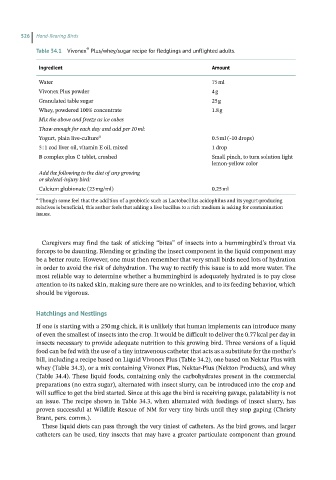Page 528 - Hand rearing birds second
P. 528
526 Hand-Rearing Birds
®
Table 34.1 Vivonex Plus/whey/sugar recipe for fledglings and unflighted adults.
Ingredient Amount
Water 75 ml
Vivonex Plus powder 4 g
Granulated table sugar 25 g
Whey, powdered 100% concentrate 1.8 g
Mix the above and freeze as ice cubes
Thaw enough for each day and add per 10 ml:
Yogurt, plain live‐culture a 0.5 ml (∼10 drops)
5 : 1 cod liver oil, vitamin E oil, mixed 1 drop
B complex plus C tablet, crushed Small pinch, to turn solution light
lemon‐yellow color
Add the following to the diet of any growing
or skeletal‐injury bird:
Calcium glubionate (23 mg/ml) 0.25 ml
a Though some feel that the addition of a probiotic such as Lactobacillus acidophilus and its yogurt‐producing
relatives is beneficial, this author feels that adding a live bacillus to a rich medium is asking for contamination
issues.
Caregivers may find the task of sticking “bites” of insects into a hummingbird’s throat via
forceps to be daunting. Blending or grinding the insect component in the liquid component may
be a better route. However, one must then remember that very small birds need lots of hydration
in order to avoid the risk of dehydration. The way to rectify this issue is to add more water. The
most reliable way to determine whether a hummingbird is adequately hydrated is to pay close
attention to its naked skin, making sure there are no wrinkles, and to its feeding behavior, which
should be vigorous.
Hatchlingsand Nestlings
If one is starting with a 250 mg chick, it is unlikely that human implements can introduce many
of even the smallest of insects into the crop. It would be difficult to deliver the 0.77 kcal per day in
insects necessary to provide adequate nutrition to this growing bird. Three versions of a liquid
food can be fed with the use of a tiny intravenous catheter that acts as a substitute for the mother’s
bill, including a recipe based on Liquid Vivonex Plus (Table 34.2), one based on Nektar Plus with
whey (Table 34.3), or a mix containing Vivonex Plus, Nektar‐Plus (Nekton Products), and whey
(Table 34.4). These liquid foods, containing only the carbohydrates present in the commercial
preparations (no extra sugar), alternated with insect slurry, can be introduced into the crop and
will suffice to get the bird started. Since at this age the bird is receiving gavage, palatability is not
an issue. The recipe shown in Table 34.3, when alternated with feedings of insect slurry, has
proven successful at Wildlife Rescue of NM for very tiny birds until they stop gaping (Christy
Brant, pers. comm.).
These liquid diets can pass through the very tiniest of catheters. As the bird grows, and larger
catheters can be used, tiny insects that may have a greater particulate component than ground

